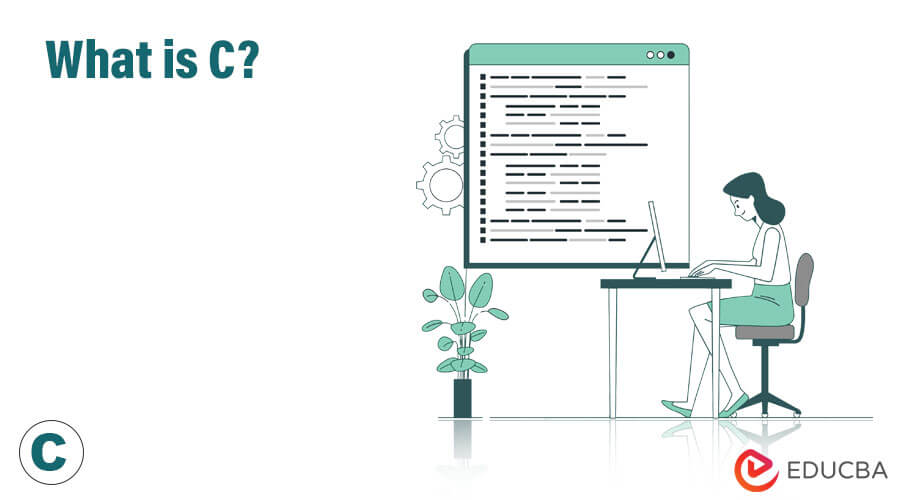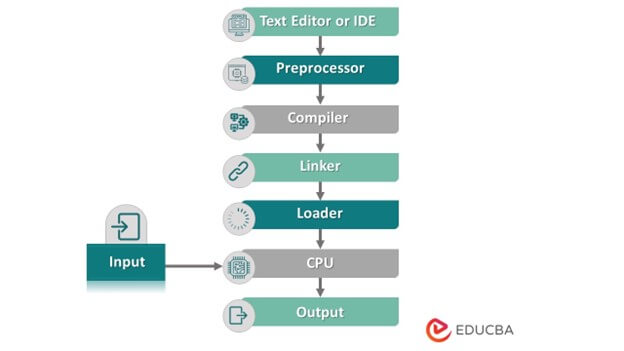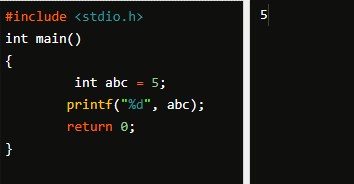Updated October 9, 2023
Introduction to C
C has played a pivotal role in shaping today’s technological landscape. It is one of the most popular and oldest programming languages, known for its versatility, efficiency, and speed. It was designed as the system programming language for Unix OS but gained popularity due to its portability and flexibility. It is a portable language, meaning written code can easily be compiled and run on other operating systems and platforms.
It is the language of technology and innovation, powering everything from the operating system to smartphones. It contains the applications of video games, mobile applications, and system software. The key strength of this language is to access and manipulate the memory address. The syntax of c language is simple, so it allows efficient memory management. Whether you are an aspiring developer or a computer science student, understanding C is necessary for unlocking programming secrets.
Table of Content
History
The below table shows the history in tabular format as follows.
| Year | Developed by | Language | Milestone |
| 1969 | Ken Thompson, Dennis Ritchie | Unix | The Unix operating system begins at Bell Labs. |
| 1970 | Ken Thompson, Dennis Ritchie | B | Ken Thompson and Dennis Ritchie worked on developing a programming language for Unix called B language. |
| 1971 | Dennis Ritchie | C | Dennis Ritchie created the successor of B, which is called C. |
| 1972 | Dennis Ritchie | Unix and C | Unix operating system is written in C and made portable on different computer platforms. |
| 1978 | Dennis Ritchie and Brian | C language with updated feature | Dennis Ritchie and Brian write the first edition of the C language book. Also, it was published in the same year. |
| 1983 | Dennis Ritchie | C language | ANSI forms the committee to standardize the C programming language. |
| 1989 | Dennis Ritchie | ANSI C | The ANSI C standard will be released and established as the uniform decision of the C programming language. |
| 1990 | Dennis Ritchie | C language | The ISO adopts the standard C language as the international standard of the C language. |
| 1999 | Dennis Ritchie | C99 standard | This year C99 standard is released for adding new features to the C programming language. |
| 2011 | Dennis Ritchie | C11 Standard | This year C11 standard is released to expand new features to the C programming language. |
C Language Basics
- It is among the most popular languages among developers as it is easy to learn, produces efficient programs, is a structured language, can handle low-level activities, and can be compiled on various computers.
- C language has B language as its primary parent language, which was developed in the 1970s.
- The ANSI (American National Standard Institute ) formalized this language as an official programming language in 1988.
- It is the most popular choice for system-friendly programming languages.
- The main reason for using C language as the system-specific programming language is its high speed and efficiency, which is close to the assembly language.
- Allows the development of state-of-art software.
- C programs have an extension of .c after the filename.
Features
It contains multiple features. Below are the features as follows.
- Low-level access – Provides low-level access to computer hardware, allowing programmers to write code that interacts with memory and hardware resources.
- Portable – We can compile and run code on any platform with small or no modifications.
- Structured programming – Supports the structured programming language that helps us break down complex code into smaller components. This will make it easier to maintain and debug the large code.
- Extensible – We can extend the C programming language using libraries and other modules that add new functionality to the programs.
- Efficient – It is known for its efficiency and speed, making it the ideal language in system programming.
- Pointers – It provides the feature called pointers, which directly access memory location and manipulate the data.
- Library support – It contains a vast library with data types and built-in functions that provide a wide range of functionality.
- Recursion – It supports recursion, which allows the function to call itself and solve complex problems.
- Runtime environment – It does not require any runtime environment, meaning c programs will be compiled directly into machine code and run without additional software.
Working
The below diagram shows the working as follows. C programming language involves the below steps in its program execution as follows.
- Source code – The developer writes the source code using a text editor or its favorite IDE.
- Compilation – The compiler translates the written source code into machine code, and the compiler executes the compiled code.
- Object code – The compiler output contains the object code, a collection of data, and machine code instructions.
- Linking – After compilation, the object code is linked with libraries using a linker, combining the object code with the library code and creating the executable file.
- Executable file – It’s a binary file that will run on a computer. It contains the data and machine code instructions required to execute the program.
- Loading – OS loads the executable file into memory after loading and prepares it for execution.
- Execution – After loading, the code is executed using a computer to manage the resource allocation like CPU, memory, input, and output.
- Debugging – If there is any code error, a developer can use the debugger to identify and fix the problem.
- Iteration – The developer makes a code change, compiles it again, and executes the program repeatedly until achieving the desired outcome.
Basic Commands
Below are the basic commands of the C programming language as follows.
1. Header file [#include <stdio.h>]
This command consists of the standard input and output. There are multiple header files contained in the C programming language. A preprocessor processes all the lines that start with the #. Below are the header files as follows.
- stddef.h – This header file contains several C programming types and macros such as (ptrdiff_t, NULL, size_t, and offset of C). These are frequently used in memory allocation and manipulation processes.
- stdint.h – Exact-width integer types like int8t,int16t,uint32t, etc., are defined in this header file. This makes it easier to create portable code, especially when working with systems of different architecture.
- stdlib.h – This header file offers functions for performing numerical conversions, dynamic memory allocation and deallocation(malloc(),realloc(),calloc(), free(), sorting and searching arrays(qsort(), bsearch()) and other useful functions.
- string.h – This header file contains functions for handling strings, like copying(strcpy(), strncpy()), comparing(strcmp(), strncmp()), searching(strchr(),strstr()), concatenating(strcat(),strncat()) strings.
- math.h – Offers mathematical functions like exponential and logarithmic functions(exp(), log()), trigonometric functions(sin(), cos(), tan()), and many more mathematical operations.
2. Int main()
The main function from which the program begins its execution. It is also an entity point of the C program. The empty bracket with this method indicates that the main method is not taking any input parameters.
3. Body of main method ({, })
This command indicates the start and end of the main function. All the function in this programming language starts and ends with curly brackets.
4. printf
We are using printf to print the output on the console.
5. scanf
This command reads input from the console.
6. if…else
This loop is used for making decisions.
7. getch();
This command is used for any of the characters from the keyboard.
8. return 0;
This command is used to terminate the c program and, after termination, return the 0.
9. While
This is another type of loop that is utilized for repetitive tasks.
10. Break
This command breaks it out from the loop.
11. Continue
This command is used to skip the loop iteration and continue with the next iteration.
Below is the simple code that explains the above commands as follows. We have declared stdio.h library.
Code:
#include
int main()
{
int abc = 5;
printf("%d", abc);
return 0;
}Output:
Applications
Below are the different applications as follows:
- Operating systems: C language’s flexibility and versatility make it suitable for the efficient development of operating systems.
- Microcontrollers: C compiler directly converts code into machine language, allowing maximum control with a minimal set of commands, making it a good choice for microcontrollers.
- Scientific systems: Allows the building and creation of many scientific systems.
- Assemblers: Can create assemblers that are put to use to execute machine-level hardware-specific systems.
- Text Editors: Can create lightweight text editors.
- Print spoolers: Develops the software program responsible for sending jobs to the printer once the command fires.
- Network drivers: Create network drivers responsible for accessing the internet and running WIFI and other kinds of drivers.
- Modern programs: Develop modern programs requiring less memory and work closer to hardware communication.
- Databases: Creates software to store a massive amount of data.
- Language interpreters: Develop software responsible for changing language types from high-level to machine-level language.
- Utilities: Helps to develop various command and program system-specific utilities.
Advantages and Disadvantages
Given below are the advantages and disadvantages as follows:
| Advantages | Disadvantages |
|
Building block for major programming languages |
Devoid of OOPS concept |
|
Fast and efficient language |
No strict type-checking |
|
Highly portable and interoperable |
No checks for runtime |
|
Rich set of built-in and user-defined functions |
No provision for having a namespace |
|
Extendable with library functions |
No concept of a constructor and destructor |
Difference Between C and C++
Below are the differences as follows:
| Feature | C | C++ |
| Paradigm | Procedural programming | Object-oriented programming |
| Class | Not supported | Supported |
| Object | Not supported | Supported |
| Encapsulation | Not supported | Supported |
| Inheritance | Not supported | Supported |
| Polymorphism | Not supported | Supported |
| Function overloading | Not supported | Supported |
| Operator overloading | Not supported | Supported |
| Templates | Not supported | Supported |
| Exception handling | Not supported | Supported |
| Reference types | Not supported | Supported |
| Default function arguments. | Not supported | Supported |
| Reference types | Not supported | Supported |
| Standard library | Basic library | Standard template library |
Conclusion
Various programming tasks can be accomplished well using C, and developers continue to find it a valuable tool today. Regardless of the emergence of newer programming languages, it continues to be widely used in many industries and significantly impacts the development of other programming languages such as C++, Java, and Python. It also contains multiple libraries and tools influenced by other programming languages. Even though learning the C programming language can be challenging, many programmers find it to be a valuable tool due to its versatility and power.
Frequently Asked Questions (FAQs)
Q1. How does C programming work?
Answer: C programs follow a sequential execution model. The source code is written in a text file and then compiled using a C compiler, which converts it into machine-readable binary code. The compiled code is then executed, allowing the program to perform its intended tasks.
Q2. How does memory management work in C?
Answer: In C, memory management is manual. Programmers must explicitly allocate and deallocate memory using functions like malloc() and free(), making it essential to manage memory carefully to avoid memory leaks and other issues.
Q3. Can C be used for web development?
Answer: While C is not commonly used for web development due to its low-level nature, it can be employed in certain specific cases like writing CGI scripts or server-side applications where performance and efficiency are critical.
Recommended Articles
We hope that this EDUCBA information on “What is C?” was beneficial to you. You can view EDUCBA’s recommended articles for more information.




